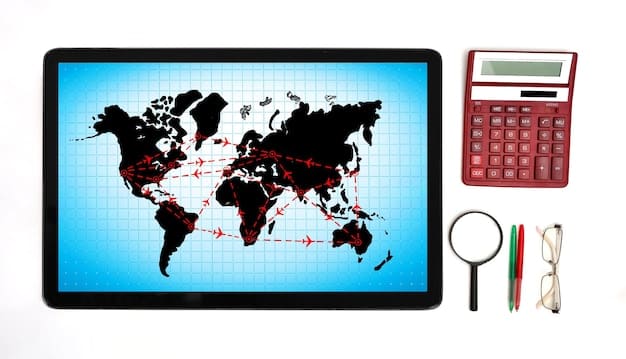Supply Chain Resilience: Adapting to Rising Shipping Costs

Supply Chain Resilience: Adapting to the Predicted 15% Increase in Shipping Costs examines proactive strategies for businesses to navigate rising shipping costs, focusing on diversification, technology adoption, and strategic partnerships.
The global supply chain is facing unprecedented challenges, with a predicted 15% increase in shipping costs looming on the horizon. Supply Chain Resilience: Adapting to the Predicted 15% Increase in Shipping Costs isn’t just a necessity—it’s the key to survival and sustained growth for businesses of all sizes.
Understanding the Looming Threat: Rising Shipping Costs
Rising shipping costs are a multifaceted issue, driven by factors ranging from geopolitical instability to increased demand fueled by e-commerce booms. Understanding these drivers is crucial for developing effective resilience strategies.
Factors Contributing to Shipping Cost Increases
Several key factors are converging to push shipping costs upward. These factors need consideration when building a resilient supply chain.
- Geopolitical Instability: Conflicts and tensions disrupt trade routes and increase insurance premiums.
- E-commerce Boom: Increased online shopping continues to strain existing shipping infrastructure.
- Environmental Regulations: New regulations aimed at reducing emissions can increase operational costs for shipping companies.
By identifying and understanding these factors, businesses can proactively mitigate the impact of rising shipping costs on their bottom line.

Diversification: The Cornerstone of Supply Chain Resilience
Diversification in supply chain strategies is essential for mitigating risks associated with rising shipping costs. Relying on a single source or route can leave businesses vulnerable to disruptions and price hikes.
Exploring Alternative Shipping Routes and Modes
Diversifying shipping routes and modes can reduce reliance on congested or expensive options.
- Nearshoring: Moving production closer to the target market reduces shipping distances and reliance on overseas transport.
- Rail and Road Transport: Utilizing rail and road transport for shorter distances can be more cost-effective than sea freight.
- Smaller Ports: Exploring smaller, less congested ports can expedite shipping and reduce delays.
Diversification offers businesses the flexibility to adapt to changing conditions and minimize the impact of rising shipping costs.
Technology Adoption: Enhancing Visibility and Efficiency
Technology plays a critical role in enhancing supply chain visibility and improving efficiency. From real-time tracking to predictive analytics, technology enables businesses to make informed decisions and optimize operations.
Leveraging Technology to Reduce Shipping Costs
Technology offers several tools for managing and optimizing shipping costs.
Adopting the below solutions is a crucial step.
- Real-Time Tracking: Tracking shipments in real-time allows businesses to identify and address potential delays or disruptions proactively.
- Predictive Analytics: Using data analytics to forecast demand and optimize inventory levels can reduce the need for expedited shipping.
- Automation: Automating warehouse operations and logistics processes can improve efficiency and reduce labor costs.
By embracing technology, businesses can gain a competitive edge and mitigate the impact of rising shipping costs.
Strategic Partnerships: Collaborating for Mutual Benefit
Strategic partnerships with suppliers, logistics providers, and even competitors can create opportunities for cost savings and improved resilience.
The Power of Collaboration in Mitigating Costs
Businesses can achieve more by collaborating with strategic partners.
Sharing capacity allows for efficient resource utilization.
- Joint Procurement: Pooling resources with other businesses to negotiate better rates with shipping companies.
- Capacity Sharing: Sharing warehouse space and transportation resources to reduce costs and improve efficiency.
- Data Sharing: Exchanging data with partners to improve forecasting and optimize supply chain operations.
Strategic partnerships enable businesses to leverage collective strengths and navigate challenges more effectively.

Inventory Management: Optimizing Stock Levels for Cost Savings
Effective inventory management is crucial for minimizing storage costs and reducing the need for expedited shipping. Balancing supply and demand can significantly impact overall shipping expenses.
Strategies for Efficient Inventory Control
Implementing effective inventory strategies can lead to cost savings and better resource utilization.
Embracing the solutions below will prove to be effective.
- Just-in-Time (JIT) Inventory: Minimizing inventory levels by receiving goods only when needed for production.
- ABC Analysis: Categorizing inventory based on value and prioritizing control efforts accordingly.
- Demand Forecasting: Using historical data and market trends to predict future demand and optimize stock levels.
Efficient inventory management reduces waste, minimizes storage costs, and improves overall supply chain efficiency.
Risk Management: Identifying and Mitigating Potential Disruptions
Proactive risk management is essential for anticipating and mitigating potential disruptions to the supply chain. Identifying vulnerabilities and developing contingency plans can minimize the impact of unforeseen events.
Building a Resilient Supply Chain Through Risk Management
A resilient supply chain can be built through continuous risk assessment and proactive mitigation strategies.
Risk management and identification is critical to business resilience.
- Risk Assessment: Identifying potential threats and vulnerabilities in the supply chain.
- Contingency Planning: Developing backup plans for key processes and resources.
- Supply Chain Mapping: Visualizing the entire supply chain to identify critical nodes and potential bottlenecks.
By identifying and addressing potential risks, businesses can enhance their resilience and minimize the impact of disruptions and increased shipping costs.
| Key Point | Brief Description |
|---|---|
| 🚢 Diversification | Use varied shipping routes and modes like nearshoring to reduce risk. |
| 💻 Tech Adoption | Implement tracking, analytics, and automation for efficiency. |
| 🤝 Strategic Partnerships | Collaborate for joint procurement and shared resources. |
| 📦 Inventory Control | Optimize stock levels with JIT and demand forecasting methods. |
Frequently Asked Questions
Supply chain resilience is how well a supply chain can bounce back from disruptions. It includes being able to handle problems and adjust to changes, ensuring the flow of goods and services remains smooth.
Shipping costs are expected to rise due to factors like geopolitical tensions, increased demand from e-commerce, and new environmental regulations. These issues create bottlenecks and raise operational expenses.
Diversification reduces reliance on single routes or suppliers. Using multiple shipping methods, like rail or nearshoring, can lower costs and provide flexibility when disruptions occur.
Technology enhances visibility and efficiency. Real-time tracking and predictive analytics help businesses make informed decisions, optimize inventory, and reduce the impact of rising shipping costs.
Strategic partnerships enable collaboration. Pooling resources and sharing data improve forecasting and optimize operations. This approach allows businesses to leverage collective strengths to navigate challenges efficiently.
Conclusion
In conclusion, adapting to the predicted 15% increase in shipping costs requires a multifaceted approach centered on diversification, technology adoption, strategic partnerships, inventory management, and risk management. By proactively implementing these strategies, businesses can enhance their supply chain resilience, mitigate the impact of rising costs, and sustain growth in an increasingly challenging global market.




